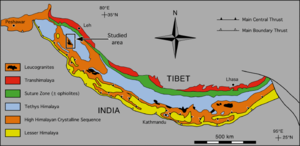Difference between revisions of "Main Central Thrust"
Hongcheng G (talk | contribs) |
Hongcheng G (talk | contribs) |
||
| Line 1: | Line 1: | ||
The '''Main Central Thrust''' is one of the north-dipping and NW—SE strike thrust faults along the Himalaya<ref>Upreti, B. N. "An overview of the stratigraphy and tectonics of the Nepal Himalaya." Journal of Asian Earth Sciences 17.5 (1999): 577-606.</ref>. Generally speaking, the Main Central Thrust is the ductile shear zone, along which the Great Himalayan Crystalline complex was placed over the Lesser Himalayan Sequence.<ref name=":2">Helm, A., and A. Gansser. "Central Himalaya, Geological observations of the Swiss expedition 1936." Mdmoires de la Socidtd Helvdtique des Sciences Naturelles 73.1,245 (1939).</ref><br /> | The '''Main Central Thrust''' is one of the north-dipping and NW—SE strike thrust faults along the Himalaya<ref>Upreti, B. N. "An overview of the stratigraphy and tectonics of the Nepal Himalaya." Journal of Asian Earth Sciences 17.5 (1999): 577-606.</ref>. Generally speaking, the Main Central Thrust is the ductile shear zone, along which the Great Himalayan Crystalline complex was placed over the Lesser Himalayan Sequence.<ref name=":2">Helm, A., and A. Gansser. "Central Himalaya, Geological observations of the Swiss expedition 1936." Mdmoires de la Socidtd Helvdtique des Sciences Naturelles 73.1,245 (1939).</ref><br /> | ||
| + | |||
| + | [[File:2 2 himal tecto units.png|thumbnail|Figure 1. Simplified geological map showing the tectonic units of Himalaya<ref>Dèzes, Pierre, and Albrecht Steck. "Tectonic and metamorphic evolution of the central Himalayan domain in southeast Zanskar (Kashmir, India)." (1999).</ref>. The Main Central Thrust is indicated by solid line and triangles.]] | ||
==Geologic background== | ==Geologic background== | ||
The Himalayan orogen is the production of the collision between continents of India and Asia. It is structurally dominated by three north-dipping, fault—bound units stacked by, from north to south, the Southern Tibetan Detachment, the Main Central Thrust, the Main Boundary Thrust and the Main Frontal Thrust<ref name=":2"/>. These units, from south to north, are: | The Himalayan orogen is the production of the collision between continents of India and Asia. It is structurally dominated by three north-dipping, fault—bound units stacked by, from north to south, the Southern Tibetan Detachment, the Main Central Thrust, the Main Boundary Thrust and the Main Frontal Thrust<ref name=":2"/>. These units, from south to north, are: | ||
| − | |||
| + | (1) The Lesser Himalayan Sequence (LHS), mainly low-grade Proterozoic metasediments to unmetamorphosed rocks, which is bound above by the Main Central Thrust. | ||
| + | (2) The Greater Himalayan Crystalline complex (GHC), mainly high-grade gneiss and migmatite, which is bound below and above by the Main Central Thrust and the Southern Tibetan Detachment, respectively | ||
| + | (3) The Tethyan Himalayan Sequence (THS), mainly Proterozoic to Eocene sediments. deformed in an Paleogene fold-thrust belt.<ref name=":4">Webb, A. Alexander G. "Preliminary balanced palinspastic reconstruction of Cenozoic deformation across the Himachal Himalaya (northwestern India)." Geosphere 9.3 (2013): 572-587.</ref> | ||
| + | See figure 2 for the structural relationships between rock units and faults. | ||
| + | [[File:Schematic illustration of the fault system of Himalaya|thumbnail|Figure 2. Schematic illustration of the fault system of Himalaya. LHS: the Lesser Himalayan Sequence; GHC: the Greater Himalayan Crystalline complex; THS: the Tethyan Himalayan Sequence; MFT: the Main Frontal Thrust; MBT: the Main Boundary Thrust; MCT: the Main Central Thrust; STD: the Southern Tibetan Detachment]] | ||
| + | == | ||
==References== | ==References== | ||
{{reflist}} | {{reflist}} | ||
Revision as of 03:44, 1 December 2014
The Main Central Thrust is one of the north-dipping and NW—SE strike thrust faults along the Himalaya[1]. Generally speaking, the Main Central Thrust is the ductile shear zone, along which the Great Himalayan Crystalline complex was placed over the Lesser Himalayan Sequence.[2]

Geologic background
The Himalayan orogen is the production of the collision between continents of India and Asia. It is structurally dominated by three north-dipping, fault—bound units stacked by, from north to south, the Southern Tibetan Detachment, the Main Central Thrust, the Main Boundary Thrust and the Main Frontal Thrust[2]. These units, from south to north, are:
(1) The Lesser Himalayan Sequence (LHS), mainly low-grade Proterozoic metasediments to unmetamorphosed rocks, which is bound above by the Main Central Thrust. (2) The Greater Himalayan Crystalline complex (GHC), mainly high-grade gneiss and migmatite, which is bound below and above by the Main Central Thrust and the Southern Tibetan Detachment, respectively (3) The Tethyan Himalayan Sequence (THS), mainly Proterozoic to Eocene sediments. deformed in an Paleogene fold-thrust belt.[4] See figure 2 for the structural relationships between rock units and faults.
==
References
- ↑ Upreti, B. N. "An overview of the stratigraphy and tectonics of the Nepal Himalaya." Journal of Asian Earth Sciences 17.5 (1999): 577-606.
- ↑ 2.0 2.1 Helm, A., and A. Gansser. "Central Himalaya, Geological observations of the Swiss expedition 1936." Mdmoires de la Socidtd Helvdtique des Sciences Naturelles 73.1,245 (1939).
- ↑ Dèzes, Pierre, and Albrecht Steck. "Tectonic and metamorphic evolution of the central Himalayan domain in southeast Zanskar (Kashmir, India)." (1999).
- ↑ Webb, A. Alexander G. "Preliminary balanced palinspastic reconstruction of Cenozoic deformation across the Himachal Himalaya (northwestern India)." Geosphere 9.3 (2013): 572-587.